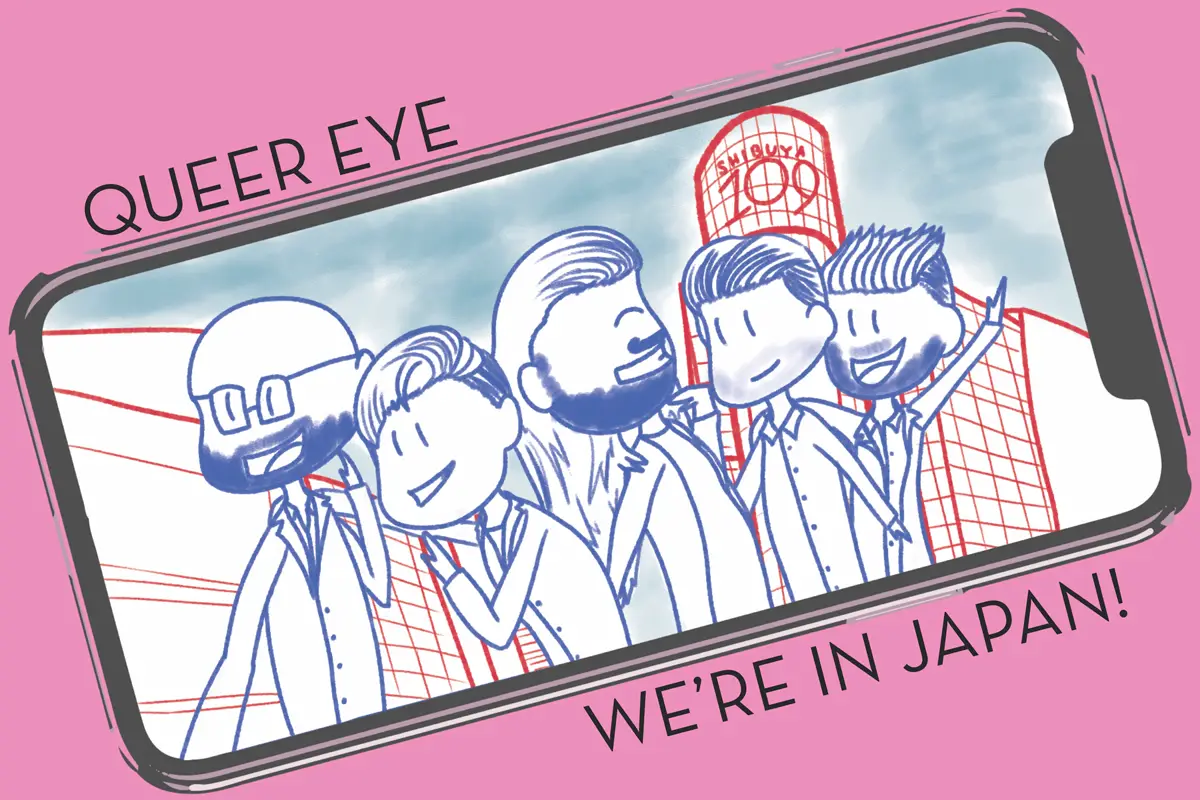“Queer Eye” with the current Fab Five — Karamo (culture expert), Antoni (food & wine expert), Tan (fashion expert), Jonathan (grooming expert) and Bobby (design expert) — is a remake of the 2003 reality television show of the same name. The premise remains the same: Five queer professionals makeover a “hero” who is nominated by a loved one. However, the new “Queer Eye” pushed boundaries that the old “Queer Eye” didn’t dare to cross in the early 2000s. The first four seasons have made over women, gay men and a transgender man, in contrast to the previous demographic of mainly straight men.
So, taking the show abroad shouldn’t come as a surprise. A special mini season, “Queer Eye: We’re in Japan!” dropped exclusively on Netflix on Nov. 1. This new setting is a reason for both excitement and caution. The Fab Five are Americans going into Japan to makeover somebody — how is “Queer Eye: We’re in Japan!” going to respect Japanese culture while imparting their values of self-love and self-care? America has a history of cultural imperialism; the classic savior complex is often hidden under the guise of “helping others,” which is eerily similar to the structure of the show.
In past seasons, “Queer Eye” has been about bringing out the strengths of their heroes rather than changing who they are to fit societal standards. It’s nice to see that, for the most part, “Queer Eye: We’re in Japan!” continues that theme with their makeovers in Japan rather than impose their view of how the hero should change. Instead of assuming expertise in Japanese culture, “Queer Eye: We’re in Japan!” partnered with a Japanese production company. This way they’ll have a Japanese crew on set to guide them through every little step, according to executive producer Jennifer Lane. The language barrier is overcome with the magic of an amazing translator and seamless editing; any worries that the meaningful connections that the Fab Five create with their heroes would be hindered were quickly brushed away in the first episode.
An obvious difference is the addition of Japanese American star Kiko Mizuhara as the Fab Five’s guide in Japan. In the first episode of the season, Tan asked Kiko how to greet Yoko, their first hero: “Do we hug her? Do we take our shoes off? What do we need to know?” Additional guests are brought into the hero’s life when the Fab Five feel like someone else can provide better expertise. Antoni brought in chef Yuji Takahashi to teach the preparation of the Japanese cuisine of skewered meat to Kan, the gay man who is the hero of the second episode. Karamo also set up Kan with Buddhist monk and makeup artist Kodo Nishimura to talk about what it’s like to be a gay man in Japan.
“Queer Eye: We’re in Japan!” is progressive in the deference shown to the Japanese culture they enter, but the show still isn’t perfect. Considering that a gay man is the hero of the second episode, we have to ask ourselves the following question: Who creates the standards for what it means to be a “successful” gay man? Western culture is very individualistic. There is an unspoken expectation that one has to come out in order to live a fulfilling life or else one is considered to be repressed or ashamed of oneself. However, “loudly declaring any part of one’s sexuality, whether it be gay or straight, is incongruous with South Asian cultural norms,” according to Natasha Noman, Master’s student of philosophy in South Asian studies. An unspoken acceptance between family and child rather than a bold declaration of queerness may be exactly what being out and proud entails in another culture.
While Kan’s reveal of his long-term boyfriend to his family went successfully, the pressure of the reality television cameras poses the question of authenticity behind the whole event. How would Kan’s mother and brother have reacted if the whole world wasn’t watching them and expecting a feel-good story? Viewers only see the dinner scene and a follow-up interview with the mother; they never know what happened when the cameras were taken away.
The danger of pushing boundaries, as “Queer Eye” generally does so well, also lies in the responsibility of representation. Kan’s story may provide hope for viewers like him, but it ignores the individuality of everybody’s experience. Other people’s families might not be as accepting of queerness yet, and while Kan’s experience was positive, coming out may not be safe for everybody.
Drawing attention to the potential issues of “Queer Eye: We’re in Japan!” shouldn’t take away from the touching moments the show cultivates. In the first episode, Yoko, a 57-year-old woman who runs a hospice, makes an apple pie with Antoni. While not special in itself, the pie represents motherhood and family to a woman who lost her sister and dreams of falling in love one day. It’s so special to Yoko that she describes the Tarte Tatin, the French version of an apple pie, as a “taste of happiness.” The scene ends with Antoni and Yoko dancing, a beautiful moment that encapsulates everything Antoni hopes to do with heroes — connect with people through food. Despite nearing 60 years of age, Yoko proves that one can always have new adventures that usher in a fresh wave of excitement and joy.
“Queer Eye: We’re in Japan!” is a short, four-episode season to be cherished. The show continues what it does best and even manages to achieve a new level of beautiful vulnerability. The impact of the Fab Five in Japan is perhaps even more significant considering the linguistic and cultural barriers they navigated. Their success in Japan speaks to the universal power of love for others and love for one’s self. If you find yourself needing a pick-me-up, catch an episode of this special season of “Queer Eye.” It’s something to hold viewers over until “Queer Eye” returns to America in 2020 with its fifth season set in Philadelphia.
















